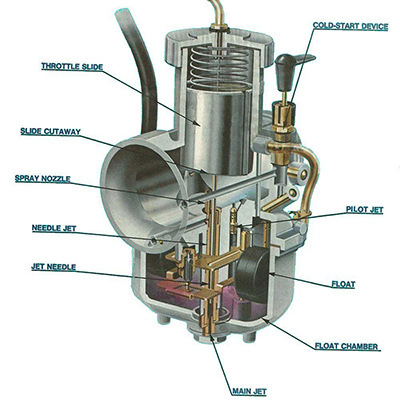Motorcycle / ATV Jetting Calculator

Motorcycle Shippers Jetting Calculator
*Manufacturers Stock Jetting can be found in the owner’s manual and is typically based on 70 degrees at 0 feet of altitude. Stock clip position should be counted from the top of the needle down (Example: 1,2,3,4,5,6 or 7)
Posted By
Posted By
Clint Lawrence, founder of Motorcycle Shippers. Lifetime motorcycle enthusiast dedicated to helping our riders. We currently don’t offer any custom jetting services or support as we are very busy shipping motorcycles. We developed this tool to assist our riders with jetting adjustments because we love riding as much as you do.
Rejetting Carbs
When you move your bike from one altitude to another adjusting the jetting of your carburetor may be necessary. Use our FREE carb jetting calculator to get your bike running at its peak. We’ve created an instant online tool to calculate the perfect jetting for your bike. Take the guesswork out of selecting the right-sized jets for your motorcycle or ATV. Support us! Motorcycle Shippers may earn a small commission from affiliate links in this article
We’ve all heard those painful sputtering noises coming from another bike sitting near us in traffic. But now, those sounds are coming from your own motorcycle. And come to think of it, you have been noticing a loss in performance on your last few rides.
If you find yourself in this situation, your motorcycle’s carburetor could be the culprit. Those spitting, sputtering noises are often its way of telling you that it needs a little TLC—aka, a rejet. Re-jetting the carburetor can be a bit complicated to do yourself, but it’s necessary to keep your motorcycle performing as it should.
You may need to adjust the main jet, pilot jet and/or clip position on the needle for your motorcycle to run at peak efficiency. You can use our calculator to find the correct settings for your carburetor by simply entering your stock jetting configuration and desired elevation with temperature.
To simplify the process for you, we’ve written this quick step-by-step guide, complete with a free rejet calculator to take the guesswork out of selecting the right sized jets for your motorcycle. Once you have determined what Jets you need for your motorcycle you can buy them here (10% Off Your First Order at JPcycles.com w/ code: TAKE10) and get a discount.
How to tell if you need to re-jet
When you jet your motorcycle’s carburetor, you’re setting the optimal ratio of air to fuel that goes into your engine. (This mix is called the stoichiometric ratio, which is 14.7 parts air to one part fuel. In reality, your motorcycle probably performs better at a slightly richer ratio.)
Carburetors contain tiny nozzles—these are the “jets”—that have holes. The fuel passes through these holes to mix with air. This creates a mist, which then travels to the combustion chamber, where it’s used as energy to run your engine. The smaller the holes in the jets, the less fuel in the air and, as a result, less explosion and less power to run your engine. By replacing your current jets with ones that have different-sized holes you can add either more fuel or air to perfect your motorcycle’s fuel-air ratio.
A number of factors can impact whether your motorcycle needs a re-jet: humidity, altitude, upgrades to your engine or exhaust system, and even the weather. Basic routine maintenance or lack of proper winterizing also comes into play here.
If your motorcycle is having carburetor issues, you’ll notice that your engine feels like it isn’t getting the fuel it needs. If you’re also hearing popping or sputtering sounds, check your spark plugs to determine if your motorcycle needs a re-jet. A clean spark plug means you can skip the re-jet. A black, sooty-looking spark plug means you’re running rich with too much fuel in your mix. If you see white residue, that means you’re running lean with too much air. In both cases, you need a re-jet.
The main jet, pilot jet, and jet needle
Before you start with your re-jetting, it’s helpful to understand the parts in your carburetor and how they control your fuel level.
- The main jet controls the amount of fuel when you’re at about 80% to a wide-open throttle
- The pilot jet controls the fuel level when you’re at idle to roughly 20% throttle
- The jet needle controls the fuel level when you’re between 20% and 80% throttle
Want to dive deeper? Watch this video on the parts of the carburetor.
Step 1: Drain your carburetor
Once you’ve checked your spark plugs and have determined you need a re-jet, it’s time to drain your carburetor. Start by shutting off the petcock, which stops gas flow from the tank to the carb. Unscrew the drain plug and let the gas run out into a pan. If you prefer, you can also accomplish this by running your engine in neutral for a few minutes—but if you go this route, make sure your motorcycle is on its stand.
With either method, the engine will eventually use up all the gas in the carb before starting to sputter and stall. This signals that your carb is as dry as possible.
Step 2: Remove your carburetor
Now, it’s time to remove the carb. Keep in mind that this process is going to be different for every motorcycle. If you’re uncertain how to remove your bike’s carburetor, refer to the service manual. (Can’t find it? You can purchase service manuals for most motorcycles on eBay.)
Step 3: Remove your hoses
Remove any hoses that are still hanging onto your bike. Take a photo of where each of them goes to avoid nightmares when it comes to reinstalling them. After this step, your carb should be fully free from your engine.
Step 4: Select the correct jet size
Not sure what size jets you need to purchase? Consult your manual first to find the stock size. Also pay attention to the numbers on the side of your old jets, which you’ll be able to see in the steps to come. A larger jet number means a bigger hole and more fuel. A smaller jet number has smaller holes and should be used if your engine needs to run leaner. Whether your machine is running too lean or too rich is a good starting point for choosing your jets, but using a jet calculator minimizes trial and error later.
(Use our free jet calculator above to determine the correct settings for your carburetor. You’ll simply enter your stock jetting configuration, desired elevation, and temperature.)
Step 5: Replace your jets
Now, it’s time for the main event. Remove your float bowl and its gasket; you should be able to do this by taking out the screws that hold it onto your carburetor. With those two pieces removed, you’ll see the main jet, which is located in the center of the carburetor, and the pilot jet, which is located directly next to it.
Unscrew the main jet and pilot jet and replace them with your new ones. Once you’re done with this step, close up your carb.
Step 6: Adjust the jet clip
To access the jet needle, you need to remove your carburetor’s diaphragm, spring, and top cap. Doing this will allow you to access the jet needle. Push the jet needle out of the diaphragm and find the clip attached to the notches; it will be near the top of the needle.
Adjust the jet clip based on your motorcycle’s needs. If you’re running rich, move the clip up one rung toward the top of the needle. If your engine needs more fuel, move the clip down one rung, toward the bottom of the needle. Slide the needle back into the diaphragm, put the diaphragm back on the carburetor body and re-attach the cap.
Step 7: Reinstall your carburetor and hoses
Reattach the carburetor to the engine. Refer to the photos you took in Step 3 to put the hoses back in their correct place.
Step 8: Test
Now it’s on to the fun part: taking your motorcycle out for a test ride. As you’re riding, pay attention to how the engine sounds and how your throttle feels. If you used our jet calculator, the spitting, sputtering noises should be gone and you should notice an improvement in your bike’s performance.
If you’re still hearing those unhealthy noises and feel like not enough fuel is getting to your engine, you likely chose the wrong jet size. If this is the case, run your engine for a bit and then check the spark plug. A clean spark plug means you’ve installed the correct-sized jets. If the black or white color persists, you need to install different-sized jets until your engine is receiving the right fuel-vs.-air ratio. This involves going back through steps 1 through 7, testing, and repeating until you find the correct jet size.
If you happen to be buying a motorcycle, we have some more tips for you in our guide to buying a used motorcycle. Want to receive more helpful motorcycle tips? Sign Up for our Newsletter below.
